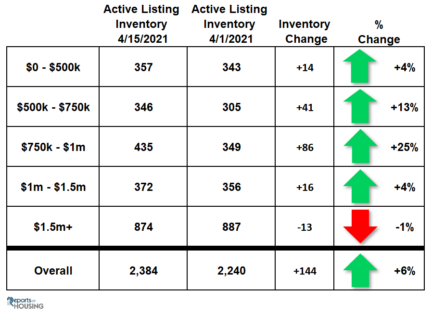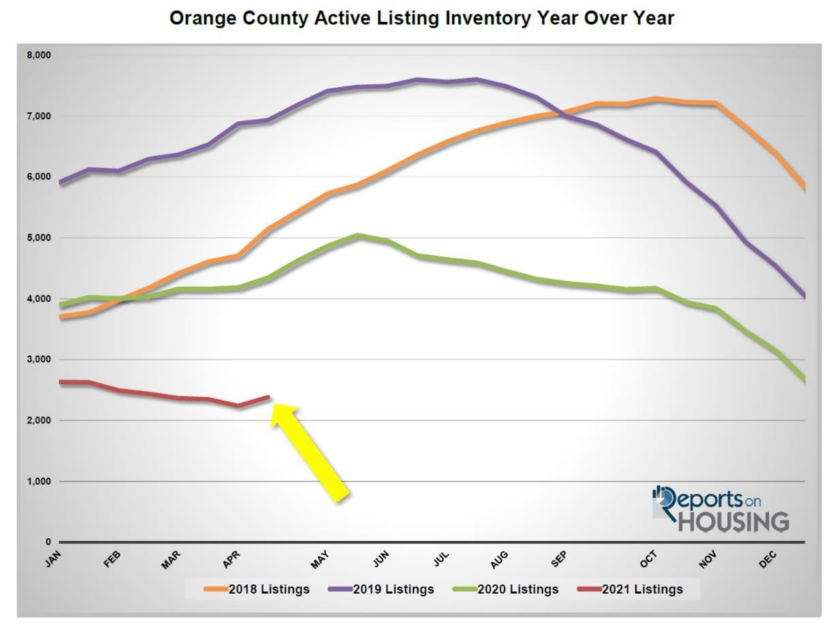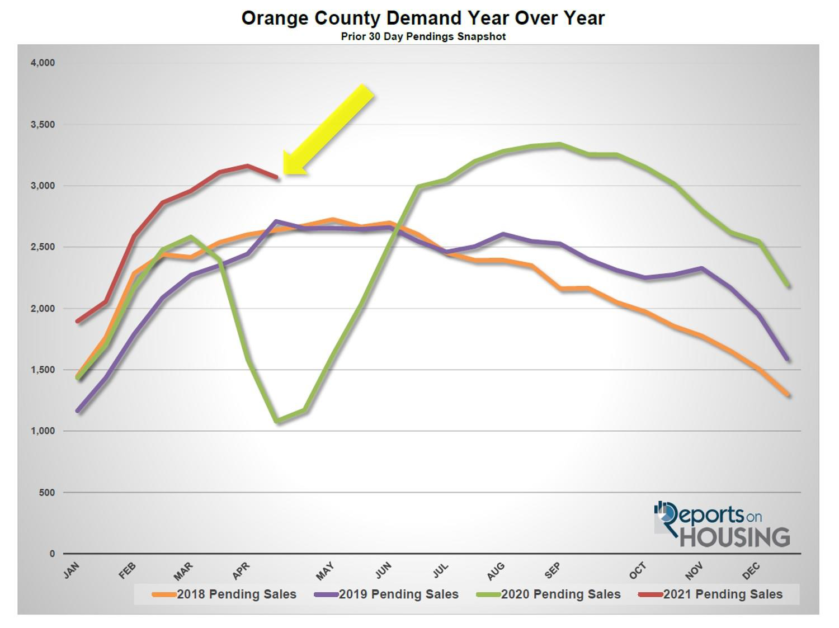
Orange County Housing Report:
Extra! Extra! Inventory Rising!

April 19, 2021
Now that the Spring Market has finally arrived, a new
trend has emerged, a rising active listing inventory.
A Rising Inventory
After continuously dropping since last October, the active listing inventory rose by 6%.
There have been years where sunny Southern California sees very little rain. Sometimes those years accumulate, and the drought becomes severe. Unfortunately, this February was the driest February on record, dating back 127 years. Southern California only received a “trace” of rain. Normally it rains nearly 4 inches during the shortest month of the year. When it finally did rain on March 3rd, the precipitation was a welcome relief.
The supply of available homes has been experiencing its own severe drought, dropping to levels not seen since records were properly maintained. At this point, any additional FOR-SALE signs hammered into the ground is a welcome relief. In the past two weeks, that is precisely what occurred in Orange County. The active listing inventory rose for the first time since last October, rising from 2,240 to 2,384 homes. The addition of 144 homes was the largest increase since May of last year.
Other than the luxury end, every price range experienced a rise in the number of homes available. The largest increases occurred in the hottest price ranges. Home priced between $500,000 to $750,000 increased by 41 additional homes, up 13%. From $750,000 to $1 million, there were 86 additional homes, up 25%. Below $500,000 and between $1 million and $1.25 million, the price ranges increased by 4%. That may not be a lot of extra homes, but for buyers, it is welcomed with open arms. The luxury price ranges above $1.5 million dropped by 13 homes, or down 1%.

Undoubtedly, for the countless buyers struggling to find a home, the extra inventory is a healthy step in the right direction. It is a new trend that should continue until it reaches a peak later in the year. In Orange County, the inventory typically does not peak until July or August. This year, it may peak even later in the year as mortgage rates are anticipated to rise from 3%, where they stand today, to as high as 3.75% by year’s end. Higher rates will decelerate the housing market and many sellers will languish on the market for a much longer period of time when they overprice. This will ultimately delay the peak. It will remain a Hot Seller’s Market, just not as nutty.
The inventory typically rises during the Spring and Summer market, but that is only part of the story behind the new evolving trend. Demand also dropped in the past couple of weeks. Escalating prices, pending and closed sales fetching values grossly over the list price, and way too many multiple offer situations is starting to influence the psyche of some buyers. The current environment is sidelining some buyers after being on the losing end of multiple attempts at securing a home.
In California, for the month of March, nearly two-thirds of all closed sales sold above their list price. Multiple offers and above list sales prices is now the norm. Watching values quickly rise after writing a dozen offers can be disconcerting. As a result, demand, a snapshot of the last 30-days of pending sales, declined by 92 in the past two weeks, down 3%, dropping from 3,162 to 3,070. With fewer pending sales, the housing market can catch its breath as the inventory rises and homes linger on the market just a bit longer than they have been.
As a result of an increasing supply of homes and a slight drop in demand, the overall Expected Market Time (the time between hammering in the FOR-SALE sign to opening escrow) increased in the past couple of weeks from 21 to 23 days. Currently, the increase may not be that detectable within the real estate trenches, but over time, as more homes accumulate on the market, the market will continue to slowly decelerate. Housing will move away from its crazy, nutty, grossly overheated pace, to a more normal, Hot Seller’s Market. That is a market where sellers need to do a bit more prep work and careful pricing is mandatory.
A Note to Sellers: It is a great time to get ahead of the curve and accurately price a home right out of the starting gates. Overpricing a home is not a sound strategy. Sellers want to expose their properties to as many potential buyers as possible. Accurately pricing permits a seller to obtain as many offers as possible. Multiple offer situations allow offers to be pit against each other and, ultimately, it maximizes the price obtained on a home. Later this year, as the market decelerates, overpricing can lead to fewer multiple offers situations and may even result in remaining on the market without success.
A Note to Buyers: Yes, the current market can be very frustrating, but waiting until more homes come on the market down the road is not the answer. With home values rapidly appreciating and mortgage rates slated to increase as well, buyers who sit on the sideline will ultimately pay more when they reenter down the road. Higher values and higher rates equate to a larger monthly payment. The market is frustrating, but staying the course and continuing to pursue paydirt is the wisest course of action for a buyer in today’s housing market.
The increase in the inventory, whatever the reason, is a much-needed welcome relief to the drought in the supply of homes. This is a new trend that will persist for the next four to six months. There will finally be more choices for buyers.
Active Listings
The current active inventory had its largest gain since May of last year.
The active listing inventory is finally coming off its record low level, adding 144 homes in the past couple of weeks, up 6%, and now sits at 2,384. Expect the supply of available homes to purchase to continue to rise throughout the Spring and Summer Markets. More homes come on the market next month in Orange County than any other month, followed by April. As demand reaches a peak and more homes come on the market, the supply will continue to climb. While the extra homes hitting the market may not be immediately noticeable, in time the accumulation will be felt and a welcome relief to its current anemic levels.
Since comparing year over year data in housing is not accurate this year due to COVID-19 skewing all housing data last year, it is much better to compare current levels to the 5-year average from 2015 to 2019. During March, there were 179 fewer new FOR-SALE signs in Orange County, 5% less than that 5-year average. This trend started in January and has resulted in 400 fewer homes on the market during the first quarter of 2021, 4% less. It is due to the lack of available replacement homes that have many homeowners alarmed about selling. They are fearful that there will be “nothing to buy,” limiting the number willing to participate in a market with such an anemic level of available homes to purchase. Yet there are strategies to avoid getting burned in selling and then purchasing a replacement home.
Last year in mid-April there were 4,344 homes on the market, 1,960 additional homes, or 82% more. The 5-year average from 2015 to 2019 is 5,765, an extra 3,381 homes, or 142% more. There were a lot more choices for buyers compared to today.

Demand
Demand dropped by 3% in past couple of weeks.
Demand, a snapshot of the number of new pending sales over the prior month, dropped from 3,162 to 3,070 in the past couple of weeks, shedding 92 pending sales, down 3%. According to Freddie Mac’s Primary Mortgage Market Survey®, rates have dropped from 3.18% on April 1st to 3.04% on April 15th. Even with the drop in interest rates, demand still dropped. A drop in demand accompanied by a drop in rates is not typical for the Spring Market and is a strong indicator that buyers are beginning to get turned off by rapidly increasing prices and are not biting on properties that are clearly overpriced. It is too soon to tell if this trend will evolve further. Typically demand continues to rise during the Spring Market and peaks anywhere from the start of April to mid-May. The peak may have already occurred two weeks ago.
Last year, demand was at 1,080, its lowest point since the Great Recession and was entirely due to the start of the pandemic. The 5-year average for demand from 2015 through 2019 was at 2,924 pending sales, 146 fewer pending sales, or 5% less.

In the past two-weeks the Expected Market Time (the number of days to sell all Orange County listings at the current buying pace) increased for the first time this year from 21 to 23 days. It remains a very Hot Seller’s Market (less than 60 days) where there are a ton of showings, sellers get to call the shots during the negotiating process, multiple offers are the norm, and home values are rising rapidly. Last year the Expected Market Time was at 121 days, drastically different than today. The 5-year average from 2015 through 2019 was at 59 days, much slower than today, but still a Hot Seller’s Market.
Luxury End
The luxury market improved in the past couple of weeks.
In the past two weeks the luxury inventory of homes priced above $1.5 million decreased by 13 homes, down 1%, and now sits at 874, its lowest level in years. At the same time, luxury demand increased by 43 pending sales, up 9%, and now sits at 522, its highest level ever. With the inventory dropping slightly and demand surging, the overall Expected Market Time for luxury homes priced above $1.5 million decreased from 56 to 50 days, its strongest level on record and is technically a Hot Seller’s Market.
Expect the luxury market to continue to improve until peak between now and mid-May.
Year over year, luxury demand is up by 428 pending sales, or 455%, and the active luxury listing inventory is down by 313 homes, or 26%. The Expected Market Time last year was at 379 days, substantially slower than today amidst the backdrop of the pandemic. Year over year statistics for luxury will be much more comparable starting in July.
For homes priced between $1.5 million and $2 million, the Expected Market Time decreased from 32 to 27 days. For homes priced between $2 million and $4 million, the Expected Market Time decreased from 53 to 45 days. For homes priced above $4 million, the Expected Market Time increased from 132 to 148 days. At 148 days, a seller would be looking at placing their home into escrow around September 2021.

Orange County Housing Summary
• The active listing inventory increased for the first time since October, adding 144 homes in the past two-weeks, up 6%, and now totals 2,384. It appears as if the inventory bottomed out two weeks ago. In March, there were 5% fewer homes that came on the market compared to 5-year average between 2015 to 2019 (2020 was skewed do to COVID-19), 179 less. Last year, there were 4,344 homes on the market, 1,960 additional homes, or 82% more.
• Demand, the number of pending sales over the prior month, decreased by 92 pending sales in the past two-weeks, down 3%, and now totals 3,070, its first drop of the year. Even with rates dropping in the past couple of weeks, demand still dropped and may have peaked a couple of weeks ago. Last year, there were 1,990 pending sales, 65% fewer than today. Keep in mind, it was the start of the pandemic too, which negatively affected demand through May.
• The Expected Market Time, the number of days to sell all Orange County listings at the current buying pace, increased for the first time this year from 21 days to 23, an extremely Hot Seller’s Market (less than 60 days). It was at 121 days last year, slower than today.
• For homes priced below $750,000, the market is a Hot Seller’s Market (less than 60 days) with an Expected Market Time of 18 days. This range represents 29% of the active inventory and 38% of demand.
• For homes priced between $750,000 and $1 million, the Expected Market Time is 16 days, a Hot Seller’s Market. This range represents 18% of the active inventory and 26% of demand.
• For homes priced between $1 million to $1.25 million, the Expected Market Time is 17 days, a Hot Seller’s Market.
• For homes priced between $1.25 million to $1.5 million, the Expected Market Time is 23 days, a Hot Seller’s Market.
• For homes priced between $1.5 million and $2 million, the Expected Market Time decreased from 32 to 27 days. For homes priced between $2 million and $4 million, the Expected Market Time decreased from 53 to 45 days. For homes priced above $4 million, the Expected Market Time increased from 132 to 148 days.
• The luxury end, all homes above $1.5 million, accounts for 37% of the inventory and only 17% of demand.
• Distressed homes, both short sales and foreclosures combined, made up only 0.5% of all listings and 0.3% of demand. There are only 6 foreclosures and 5 short sales available to purchase today in all of Orange County, 11 total distressed homes on the active market, up 3 from two-weeks ago. Last year there were 41 total distressed homes on the market, more than today.
• There were 3,212 closed residential resales in March, 35% more than March 2020’s 2,383 closed sales. March marked a 41% rise over February 2021. It was the strongest March closing month since 2005. The sales to list price ratio was 100.3% for all of Orange County. Foreclosures accounted for just 0% of all closed sales, and short sales accounted for 0.09%. That means that 99.91% of all sales were good ol’ fashioned sellers with equity.
Have a great week.
Sincerely, Steven Thomas Quantitative Economics and Decision Sciences
Cell 949.874.8221
Copyright 2021- Steven Thomas, Reports On Housing – All Rights Reserved. This report may not be reproduced in whole or part without express written permission by author.






